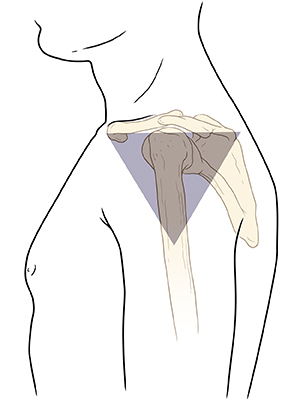A
B
C
D
E
F
G
H
I
J
K
L
M
N
O
P
Q
R
S
T
U
V
W
X
Y
Z
Topic IndexLibrary Index
Click a letter to see a list of conditions beginning with that letter.
Click 'Topic Index' to return to the index for the current topic.
Click 'Library Index' to return to the listing of all topics.
Discharge Instructions: Giving Yourself an Intramuscular (IM) Injection in the Upper Arm
Your healthcare provider has prescribed a medicine that must be given by intramuscular (IM) injection. This means you use a needle and syringe to send medicine into large muscles in your body. IM injections are usually given in the buttocks, thigh, hip, or upper arm. If you need to give yourself injections often, you need to inject a different site on your body each time. This helps prevent scars and skin problems. The injection sites should be at least 1 inch from each other. Ask your healthcare provider if you should inject the medicine in a certain site.
You were shown how to do an IM injection in the hospital. If you did not get an instruction sheet covering those general steps, ask for one. This sheet reminds you how to give an IM injection in the upper arm.
Name of your medicine: ___________________________
Amount per injection: ____________________________
Times per day: _______________________________
Step 1. Getting ready
-
Wash your hands well with soap and clean, running water or use alcohol-based hand sanitizer before and after all IM injections.
-
Prepare your medicine as you were shown by your healthcare provider.
Step 2. Finding an injection site
The site will be on the outer side of your upper arm. Imagine the shape of an upside-down triangle here. You will find a site in the center of this area. To find an injection site:
-
Touch the bone at the top of your upper arm. It's where your arm meets your shoulder. This is the top side of the upside-down triangle.
-
Move your hand about 3 to 4 inches down the outer side of your upper arm. The bottom point of the triangle is here, at about the level of your armpit.
-
The injection site is in the center of this triangle. It's about 1 to 2 inches below the bone at the top of your upper arm.

Step 3. Injecting the medicine
Prepare the site as you were shown by your healthcare provider. See the general instruction sheet on giving yourself an IM injection. If you did not get this sheet, ask for one. Then:
-
Stretch your skin tight.
-
Hold the syringe like a pencil. Insert the needle straight into your skin and into the muscle at a 90-degree angle.
-
You may be told by your healthcare provider to pull back slightly on the plunger. This is to make sure you did not hit a blood vessel with the needle. If blood appears in the syringe, remove the needle and don't inject the medicine. It might go into the bloodstream and not the muscle. Dispose of the needle and syringe in a sharps container and repeat the process in a different spot on your upper arm.
-
To inject the medicine, push down on the plunger at a steady rate.
-
Give no more than 2 mL of medicine in this site. If the prescribed dose is more than 2 mL, choose a different site to inject more medicine.
Step 4. Removing the needle
Step 5. After the injection
-
Press a gauze pad onto the site.
-
Hold the pad tightly for a minute.
-
Check the area for redness, bleeding, or bruising.
-
Apply a bandage to the site, if needed.
-
Put the needle and syringe in a sharps container.
-
Dispose of the other materials as you were shown by your healthcare provider.
-
Wash your hands well.
Medicine that comes in a container for a single dose should be used only 1 time. If you use the container a second time, it may have germs in it that can cause infections. These infections usually affect the skin and soft tissues. But some infections can affect the brain, spinal cord, or heart. Sharing another person's used needles or medicines can cause other infections, such as hepatitis B, hepatitis C, and HIV.
Follow-up care
Follow up with your healthcare provider, or as advised.
When to call your healthcare provider
Call your healthcare provider right away if any of the following occur:
-
Needle that breaks off in the injection site
-
Medicine injected into the wrong area
-
Problems that keep you from giving yourself the injection
-
Bleeding or pain at the injection site that won't stop
-
Rash or swelling at the injection site
-
Shortness of breath
-
Fever of 100.4°F (38°C) or higher, or as directed by your healthcare provider
Online Medical Reviewer:
Jessica Gotwals RN BSN MPH
Online Medical Reviewer:
Paula Goode RN BSN MSN
Online Medical Reviewer:
Robert Hurd MD
Date Last Reviewed:
7/1/2022
© 2000-2025 The StayWell Company, LLC. All rights reserved. This information is not intended as a substitute for professional medical care. Always follow your healthcare professional's instructions.